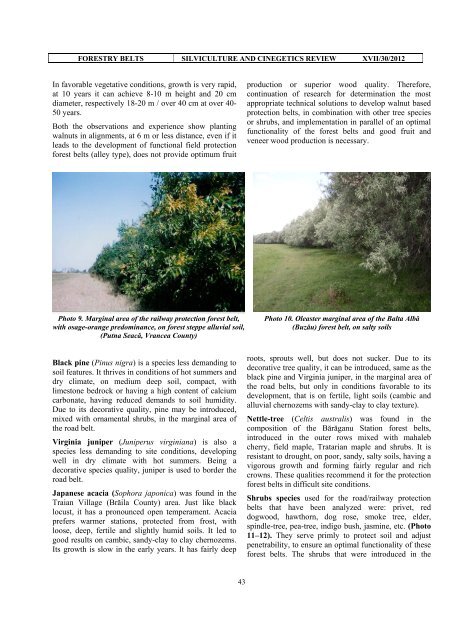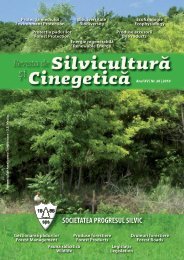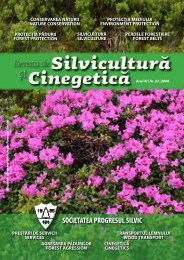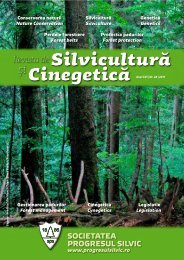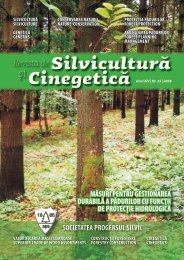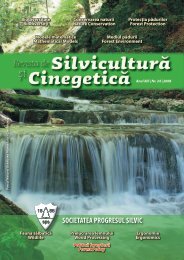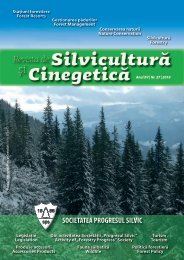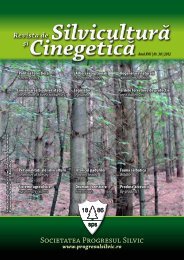Silviculture and Cinegetics Review - Societatea Progresul Silvic
Silviculture and Cinegetics Review - Societatea Progresul Silvic
Silviculture and Cinegetics Review - Societatea Progresul Silvic
You also want an ePaper? Increase the reach of your titles
YUMPU automatically turns print PDFs into web optimized ePapers that Google loves.
FORESTRY BELTS SILVICULTURE AND CINEGETICS REVIEW XVII/30/2012<br />
In favorable vegetative conditions, growth is very rapid,<br />
at 10 years it can achieve 8-10 m height <strong>and</strong> 20 cm<br />
diameter, respectively 18-20 m / over 40 cm at over 40-<br />
50 years.<br />
Both the observations <strong>and</strong> experience show planting<br />
walnuts in alignments, at 6 m or less distance, even if it<br />
leads to the development of functional field protection<br />
forest belts (alley type), does not provide optimum fruit<br />
production or superior wood quality. Therefore,<br />
continuation of research for determination the most<br />
appropriate technical solutions to develop walnut based<br />
protection belts, in combination with other tree species<br />
or shrubs, <strong>and</strong> implementation in parallel of an optimal<br />
functionality of the forest belts <strong>and</strong> good fruit <strong>and</strong><br />
veneer wood production is necessary.<br />
Photo 9. Marginal area of the railway protection forest belt,<br />
with osage-orange predominance, on forest steppe alluvial soil,<br />
(Putna Seacă, Vrancea County)<br />
Photo 10. Oleaster marginal area of the Balta Albă<br />
(Buzău) forest belt, on salty soils<br />
Black pine (Pinus nigra) is a species less dem<strong>and</strong>ing to<br />
soil features. It thrives in conditions of hot summers <strong>and</strong><br />
dry climate, on medium deep soil, compact, with<br />
limestone bedrock or having a high content of calcium<br />
carbonate, having reduced dem<strong>and</strong>s to soil humidity.<br />
Due to its decorative quality, pine may be introduced,<br />
mixed with ornamental shrubs, in the marginal area of<br />
the road belt.<br />
Virginia juniper (Juniperus virginiana) is also a<br />
species less dem<strong>and</strong>ing to site conditions, developing<br />
well in dry climate with hot summers. Being a<br />
decorative species quality, juniper is used to border the<br />
road belt.<br />
Japanese acacia (Sophora japonica) was found in the<br />
Traian Village (Brăila County) area. Just like black<br />
locust, it has a pronounced open temperament. Acacia<br />
prefers warmer stations, protected from frost, with<br />
loose, deep, fertile <strong>and</strong> slightly humid soils. It led to<br />
good results on cambic, s<strong>and</strong>y-clay to clay chernozems.<br />
Its growth is slow in the early years. It has fairly deep<br />
roots, sprouts well, but does not sucker. Due to its<br />
decorative tree quality, it can be introduced, same as the<br />
black pine <strong>and</strong> Virginia juniper, in the marginal area of<br />
the road belts, but only in conditions favorable to its<br />
development, that is on fertile, light soils (cambic <strong>and</strong><br />
alluvial chernozems with s<strong>and</strong>y-clay to clay texture).<br />
Nettle-tree (Celtis australis) was found in the<br />
composition of the Bărăganu Station forest belts,<br />
introduced in the outer rows mixed with mahaleb<br />
cherry, field maple, Tratarian maple <strong>and</strong> shrubs. It is<br />
resistant to drought, on poor, s<strong>and</strong>y, salty soils, having a<br />
vigorous growth <strong>and</strong> forming fairly regular <strong>and</strong> rich<br />
crowns. These qualities recommend it for the protection<br />
forest belts in difficult site conditions.<br />
Shrubs species used for the road/railway protection<br />
belts that have been analyzed were: privet, red<br />
dogwood, hawthorn, dog rose, smoke tree, elder,<br />
spindle-tree, pea-tree, indigo bush, jasmine, etc. (Photo<br />
11–12). They serve primly to protect soil <strong>and</strong> adjust<br />
penetrability, to ensure an optimal functionality of these<br />
forest belts. The shrubs that were introduced in the<br />
43


